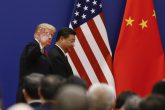August 28, 2021
To Compete With Beijing, the Quad Must Remain Pro-Asia, Not Anti-China
The Quadrilateral Security Dialogue, otherwise known as the Quad, has become a critical component in the United States’ strategy in the Indo-Pacific since it was revived in 2017. While not a formal military alliance, its four members — Australia, India, Japan, and the United States — are powerful and influential democracies that, collectively, possess the ability to push back against China’s growing regional assertiveness.
However, at its core, Southeast Asia is a region where the forces of great power competition push against critical and deep economic linkages with both the U.S. and China, thus complicating the strategic landscape. By necessity, the Quad must navigate the resulting complex set of regional attitudes toward the China-U.S. rivalry. This makes how the group identifies its purpose a delicate, but critical, balance to strike if it wants to effectively compete with Beijing in its own backyard. The first-ever in-person Quad summit, currently scheduled for late September, following the U.N. General Assembly, provides an opportunity to develop the contours of a Quad strategy to do just that.
The Quad must navigate the resulting complex set of regional attitudes toward the China-U.S. rivalry
When the group convened in Tokyo for a ministerial meeting last October, then-U.S. Secretary of State Mike Pompeo expressed support for both institutionalizing the Quad and building out a “true security framework.” The Biden administration has so far focused more of its attention on non-security related issues – like vaccines, technology, and climate change. Now, with the Quad’s future a subject of continued debate, policymakers should look to the sentiments from across Southeast Asia for insights.
A recent influential public opinion poll of regional elites reveals that one of the greatest concerns expressed about the 10-member Association of Southeast Asian Nations (ASEAN) is that the institution “is becoming an arena of major power competition and its member states may become proxies of a major power.” When it comes to perceived challenges facing the region, respondents ranked the top three as the COVID-19 pandemic, unemployment and economic recession, and widening socioeconomic gaps and rising income disparity.
Read the full article from The Diplomat.
More from CNAS
-
Why Chinese Car Investments Are a National-Security Risk
If the U.S. wants to win the competition for technology and security, it must distinguish between productive investment and Trojan horses....
By David Feith
-
Geoeconomics Summit 2025 - The Changing Dynamics of Statecraft
David Feith, adjunct senior fellow at CNAS, participated in a panel during an Institute of Geoeconomics summit in Tokyo to compare geoeconomic statecraft under the Biden and T...
By David Feith
-
Trump Heads to Asia with High-Stakes Meeting with China’s Xi on the Agenda
President Donald Trump departed Washington Friday night for Asia with trade and U.S. relations with China top of mind. He is set to hold a high-stakes sit-down with Chinese Pr...
By Jacob Stokes
-
Defense / Indo-Pacific Security
Is the U.S. Ready for War with China?U.S. military planners are caught in an impossible dilemma....
By Franz-Stefan Gady




